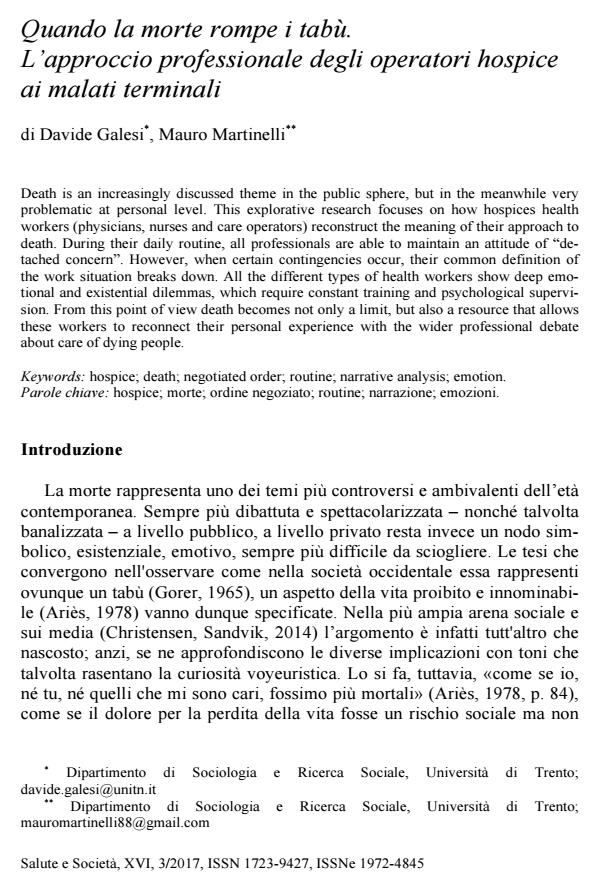Quando la morte rompe i tabù. L’approccio professionale degli operatori hospice ai malati terminali
Journal title SALUTE E SOCIETÀ
Author/s Davide Galesi, Mauro Martinelli
Publishing Year 2017 Issue 2017/3 Language Italian
Pages 14 P. 119-132 File size 80 KB
DOI 10.3280/SES2017-003010
DOI is like a bar code for intellectual property: to have more infomation
click here
Below, you can see the article first page
If you want to buy this article in PDF format, you can do it, following the instructions to buy download credits

FrancoAngeli is member of Publishers International Linking Association, Inc (PILA), a not-for-profit association which run the CrossRef service enabling links to and from online scholarly content.
Death is an increasingly discussed theme in the public sphere, but in the meanwhile very problematic at personal level. This explorative research focuses on how hospices health workers (physicians, nurses and care operators) reconstruct the meaning of their approach to death. During their daily routine, all professionals are able to maintain an attitude of "detached concern". However, when certain contingencies occur, their common definition of the work situation breaks down. All the different types of health workers show deep emotional and existential dilemmas, which require constant training and psychological supervision. From this point of view death becomes not only a limit, but also a resource that allows these workers to reconnect their personal experience with the wider professional debate about care of dying people.
Keywords: Hospice; death; negotiated order; routine; narrative analysis; emotion.
- Allievi S. (2001). L’ultimo tabù: individuo e società davanti alla morte. In; Bucchi M., Neresini F., a cura di, Sociologia della salute. Roma: Carocci.
- Ariés P. (1978). Storia della morte in occidente. Milano: Rizzoli.
- Bauman Z. (1992). Mortality, Immortality and Other Life Strategies. Oxford: Poli-ty.
- Bourdieu P. (2003). Il senso pratico. Roma: Armando.
- Broom A. (2015). Dying: a social perspective on the end of life. Burlington: Ashgate.
- Bruni A., Gherardi S. (2007). Studiare le pratiche lavorative. Milano: Feltrinelli.
- Christensen D., Sandvik K. (2014). Mediating and Remediating Death. Farnham, Surrey: Routledge.
- Conrad P. (2007). The Medicalization of Society. Baltimore: J. Hopkins U.P.
- Foucault M. (1973). The Birth of the Clinic. London: Tavistock.
- Fox J. (2006). “Notice how you feel”: an alternative to detached concern among hospice volunteers. Qualitative Health Research, 16(7): 944–961.
- Fox R.C., Lief, H. (1963). Training for “detached concern”. In: Lief H., editor, The Psychological Basis of Medical Practice. NY: Harper and Row.
- Freidson E. (1988). Profession of Medicine. Chicago: University of Chicago Press.
- Garfinkel H. (1967). Studies in Ethnomethodology. NJ: Prentice Hall.
- Giddens A. (1991). Modernity and Self-identity. Stanford: University Press.
- Good B. (2006). Narrare la malattia. Torino: Einaudi.
- Gorer G. (1965). Death, Grief and Mourning in Contemporary Britain. London: Doubleday.
- Habermas J. (1981). Teoria dell'agire comunicativo. Bologna: Il Mulino.
- Ingebretsen L.P., Sagbakken M. (2016). Hospice nurses’ emotional challenges in their encounters with the dying. International Journal of Qualitative Studies on Health and Well-Being, 11(130): 1–13.
- Marzano M. (2004). Scene finali. Morire di cancro in Italia. Bologna: Il Mulino.
- McQueen A. (2004). Emotional intelligence in nursing work. Journal of Advanced Nursing, 47(1): 101-8.
- McNamara B., Waddell C., Colvin M. (1994). The institutionalization of the good death. Social Science and Medicine, 39(11): 1501–1508.
- Nettleton S., Burrows R., Watt I. (2008). How do you feel doctor? An analysis of emotional aspects of routine professional medical work. Social Theory and Health, 6(1): 18-36.
- Parsons T. (1965). Il sistema sociale. Milano: Comunità.
- Payne S., Langley-Evans, Hillier, R. (1996). Perceptions of a “good” death: a comparative study of the views of hospice staff and patients. Palliative Medicine, 10(4): 307–12. DOI: 10.1177/02692163960100040
- Schütz A. (1974). La fenomenologia del mondo sociale. Bologna: Il Mulino.
- Sinclair S. (2011). Impact of death and dying on the personal lives and practices of palliative and hospice care professionals. Cmaj, 183(2): 180–7.
- Strauss A. (1978). Negotiations: Varieties, Contexts, Processes and Social Order. London: Jossey-Bass.
- Strauss A., Fagerhaugh S., Suczek B., Wiener C. (1982). Sentimental work in the technologized hospital. Sociology of Health and Illness, 4(3): 254–78.
- Sudnow D. (1967). Passing on: The social organization of dying. Englewood Cliffs: Prentice-Hall.
- Timmermans S. (1999). Sudden death and the myth of CPR. Philadelphia: Temple University Press.
- Tousijn W. (2004). Le professioni della salute. In: Cipolla C., a cura di, Manuale di sociologia della salute. Vol. 1. Milano: FrancoAngeli.
- Walter T. (1995). The Revival of Death. London: Routledge.
- Weick K. (1995). Senso e significato nell'organizzazione. Milano: Cortina.
- La dimensione spirituale nelle pratiche di cura del fine vita. Limiti da superare e modelli da implementare Barbara Sena, Enrico De Luca, in SALUTE E SOCIETÀ 1/2024 pp.83
DOI: 10.3280/SES2024-001006
Davide Galesi, Mauro Martinelli, Quando la morte rompe i tabù. L’approccio professionale degli operatori hospice ai malati terminali in "SALUTE E SOCIETÀ" 3/2017, pp 119-132, DOI: 10.3280/SES2017-003010